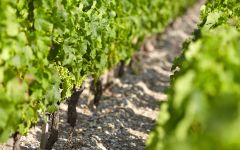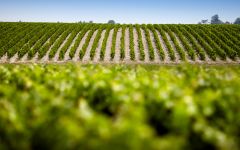Chateau Grand-Puy-Lacoste (1.5 Liter Magnum) 2016
-
James
Suckling - Decanter
-
Wine
Spectator -
Robert
Parker -
Wine
Enthusiast -
Connoisseurs'
Guide



Product Details
Your Rating
Somm Note
Winemaker Notes
Professional Ratings
-
James Suckling
A neoclassical edition of Grand-Puy-Lacoste, this has cedar, graphite, deeply integrated cedar and spicy-oak influence and a very fresh array of ripe blackberries, dark cherries and cassis. The palate is so seamless. It builds beautifully and delivers a long, seamless array of perfectly ripe dark fruit, swathed in fine, firm, ascending layers of tannins. As good as we have seen in recent vintages, this is a star of the vintage. Try from 2024.
-
Decanter
This has a punch of mouthfilling dark cassis fruits and lots of complex tobacco, liquorice and truffle. Layer upon layer of flavour is joined by tight tannins, but with air and life in between. It's young and well balanced, easily equal to the power of a Lynch Bages or a Pichon Baron. I loved it en primeur and love it again here. Consultant is Eric Boissenot, technical director is Christel Spinner.
-
Wine Spectator
A lively style, with lots of briar and tobacco notes out front, backed by punchy plum and black currant paste flavors. Has a shot of sweet tobacco lining the finish, with echoes of savory and hints of iron giving this range and length. Best from 2023 through 2038.
-
Robert Parker's Wine Advocate
The deep garnet-purple colored 2016 Grand-Puy-Lacoste gives up pure kirsch and red and black currants with violets and baking spices. Medium-bodied, firm and grainy, it's very expressive with good concentration and length.
Rating: 94+ -
Wine Enthusiast
Juicy and jammy, this wine is already smoothly textured. Its black fruits add a fresh touch and give a ripe feeling. Likely to develop quickly the wine will be ready to drink from 2022.
-
Connoisseurs' Guide
If not the flashiest or deepest member of the Pauillac contingent, the Grand-Puy-Lacoste is nevertheless a very solid representative of its commune and offers up a fine and concentrated mix of dark fruit and spice underpinned by plentiful, plainly evident Cabernet tannins. Be in no hurry and give it some time – another five or six should be about right – and know that it will continue to grow and evolve favorably as it softens and expands for no fewer than five or six more.
Other Vintages
2022- Vinous
-
Robert
Parker - Decanter
-
James
Suckling
-
James
Suckling - Decanter
-
Robert
Parker
-
James
Suckling -
Wine
Spectator - Decanter
-
Jeb
Dunnuck -
Robert
Parker
- Vinous
-
Robert
Parker -
James
Suckling - Decanter
-
Wine
Spectator -
Jeb
Dunnuck
-
Wine
Spectator - Decanter
-
Jeb
Dunnuck -
James
Suckling -
Wilfred
Wong -
Robert
Parker -
Wine
Enthusiast
- Decanter
-
James
Suckling -
Wine
Spectator -
Jeb
Dunnuck -
Wine
Enthusiast -
Wilfred
Wong -
Robert
Parker
-
James
Suckling - Vinous
-
Wine
Spectator - Decanter
-
Wine
Enthusiast -
Jeb
Dunnuck -
Robert
Parker
-
James
Suckling - Decanter
-
Wine
Enthusiast -
Wine
Spectator -
Robert
Parker
-
Wine
Spectator -
Wine
Enthusiast -
James
Suckling -
Robert
Parker
-
James
Suckling -
Wine
Enthusiast -
Robert
Parker -
Wine
Spectator
-
James
Suckling -
Wine
Enthusiast -
Wine
Spectator -
Robert
Parker
-
James
Suckling - Decanter
-
Wine
Spectator -
Wine
Enthusiast -
Robert
Parker
- Decanter
-
Jeb
Dunnuck
-
James
Suckling -
Wine
Spectator -
Robert
Parker -
Wine &
Spirits
-
Wine
Spectator
-
Wine
Spectator -
James
Suckling
-
Robert
Parker -
Wine
Spectator
-
Robert
Parker
-
Robert
Parker
-
Wine
Spectator -
Robert
Parker
-
Robert
Parker -
Wine
Spectator
-
Robert
Parker -
Wine
Spectator

One of the world’s most classic and popular styles of red wine, Bordeaux-inspired blends have spread from their homeland in France to nearly every corner of the New World. Typically based on either Cabernet Sauvignon or Merlot and supported by Cabernet Franc, Malbec and Petit Verdot, the best of these are densely hued, fragrant, full of fruit and boast a structure that begs for cellar time. Somm Secret—Blends from Bordeaux are generally earthier compared to those from the New World, which tend to be fruit-dominant.

The leader on the Left Bank in number of first growth classified producers within its boundaries, Pauillac has more than any of the other appellations, at three of the five. Chateau Lafite Rothschild and Mouton Rothschild border St. Estephe on its northern end and Chateau Latour is at Pauillac’s southern end, bordering St. Julien.
While the first growths are certainly some of the better producers of the Left Bank, today they often compete with some of the “lower ranked” producers (second, third, fourth, fifth growth) in quality and value. The Left Bank of Bordeaux subscribes to an arguably outdated method of classification that goes back to 1855. The finest chateaux in that year were judged on the basis of reputation and trading price; changes in rank since then have been miniscule at best. Today producers such as Chateau Pontet-Canet, Chateau Grand Puy-Lacoste, Chateau Lynch-Bages, among others (all fifth growth) offer some of the most outstanding wines in all of Bordeaux.
Defining characteristics of fine wines from Pauillac (i.e. Cabernet-based Bordeaux Blends) include inky and juicy blackcurrant, cedar or cigar box and plush or chalky tannins.
Layers of gravel in the Pauillac region are key to its wines’ character and quality. The layers offer excellent drainage in the relatively flat topography of the region allowing water to run off into “jalles” or streams, which subsequently flow off into the Gironde.





